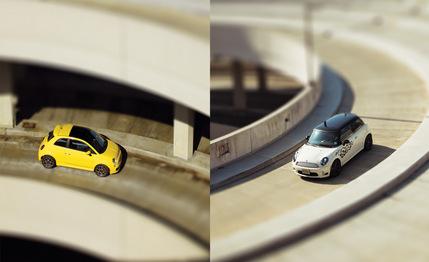
 Comparison Tests
Comparison Tests
The wide boulevards, endless expressways, and three-car garages of the United States are not what you might call prime territory for tiny city cars. Sure, they’re big business in Europe, the hatchery that birthed these automotive Peeps, with all major carmakers (including Mercedes-Benz and Audi) looking for a piece of the action. But without the need for space efficiency that guided the development of these runabouts, few Americans seem willing to put up with the resulting trade-offs. Previous efforts largely failed to break Americans out of the small-is-cheap mind-set. And cars like the quirky-but-joyless Smart Fortwo, and soon the Scion iQ, test the outer limits of American good humor.
Which makes BMW’s accomplishment with the Mini in the U.S. all the more stunning. The reborn Mini Cooper landed in 2002 with a plucky driving personality (especially the supercharged S model), a sensible base price that started in the mid-teens, and a look of tenacity that leaned heavily on the original 1957 BMC Mini’s styling. It made modern small cars cool for drivers of either gender, and its success went unnoticed by no automaker.
Taking a page from the Germans, Fiat relaunched the 500 in 2007. The nuova was bigger and, like the Mini, wore a retro skin that, according to press materials, exhibited “fashionable Italian flair.” With no means for North American production, Fiat could not finesse the business model to make a U.S. 500 profitable. But then Fiat scooped up 20 percent of Chrysler amid that corporation’s chapter 11 troubles, and its partial ownership gave Fiat access to Chrysler’s Toluca, Mexico, plant. Hello, U.S.-bound Fiats.
The current, second-generation Mini Cooper is sort of the automotive equivalent of boxer/politician Manny Pacquiao. It can fight a class size up or down. It can thrill as a sport hatch, with numerous go- and look-faster add-ons, or it can serve as a simple transportation vessel. Here we have it punching under its weight as it enters the ring with its Italian opponent.


Cinquecentos come in three flavors: Pop, Sport, and Lounge. The $18,000 Sport comes with a stiffer suspension and sport seats (plus other cosmetic bits), making it the most natural competitor to the Mini. Our highlighter-yellow hatch also came equipped with automatic climate control that is worth every cent of its modest $150 cost and an $850 sunroof that our taller drivers would pay to not have.
Base-level Coopers, which we consider the rough equivalent of the 500 Sport model, start at $20,100, or $2100 more than the Fiat. The cream-and-black test car we wrangled came with randomly applied decals we called, affectionately, warts. Of the $3500 in options, we could do without the $250 stickers and the $1500 Value package (an iPod connector and a body kit), but we absolutely require the $1000 Sport package and the $250 center armrest. We could go either way on the $500 adaptive xenon headlights.
Armed with two city cars that combine to make less power than a Hyundai Sonata 2.0T, we jetted off to a favorite C/D southern-Ohio stomping ground to see which of these retro takes on ’50s classics would win us over.